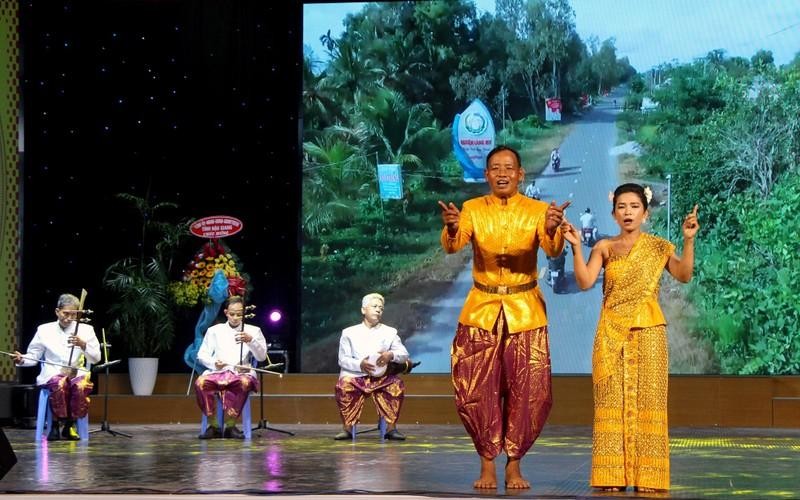A practical project to safeguard Aday singing
Given the fact that Aday folk singing in Hau Giang is facing the risk of being lost, the provincial authorities launched a project on teaching and preserving the art of Aday singing of the Khmer ethnic people in Hau Giang Province in the 2016-2020 period.
Xa Phien Commune, Long My District, which is home to a large population of Khmer people, was chosen to implement the project.
Vice Chairman of the Xa Phien Commune People's Committee Phan Hoang Minh reported that the commune has 1,097 Khmer households with 4,914 people, accounting for more than 31% of the commune's total households.
He noted with pleasure that since its launch, the project has fuelled the passion for practicing Aday folk singing among the local Khmer people.
Aday singing demonstrates Khmer people’s creativity while the songs’ lyrics focus on daily life, love, ethnic lessons, and family happiness.
Accordingly, many training courses on Aday singing have been opened at the Provincial Ethnic Minority Boarding High School and at Po Thi Vong Sa Pagoda. Each course attracts more than 50 learners, who include Khmer ethnic students as well as those interested in exploring the traditional art form.
Danh Ky, Head of the Aday Singing Club in Village 4, Xa Phien Commune, shared that by participating in the course, he has been provided with a deeper understanding of this art form and become more passionate about it. He is now actively teaching the art form to his children, grandchildren, and neighbours.
Ky said that the number of people participating in cultural exchange events in the village has increased significantly in recent years. During holidays and festivals, villagers eagerly gather together to join Aday sing performances.
Further investment needed to promote Aday singing
Hau Giang is home to around 26,000 Khmer ethic people, accounting for 3% of the province's total population. In recent years, thanks to Party and State's care, the livelihoods of Khmer ethnic people in the province have been improved and their cultural and art activities have been promoted, including the art of Aday singing.
Aday singing is a unique cultural activity of the Khmer people. It is often practiced in pagodas and families. Aday singing demonstrates Khmer people’s creativity while the songs’ lyrics focus on daily life, love, ethnic lessons, and family happiness.
 |
Participants at a raining courses on Aday singing (Photo: baodantoc.vn) |
Thach Si Phol, a celebrated Aday performer in Bac Lieu Province who has come to Hau Giang many times to teach the art form to locals, said that attention must not be attached only to training Aday vocalists, but also instrumentalists.
He stressed that without a good instrumentalist, a good Aday singer cannot deliver a convincing performance that fully captures the charm of Aday singing. Therefore, he called for further investment to help Aday singing thrive on stage.
According to Vice Chairman of Xa Phien Commune People's Committee Phan Hoang Minh, the communal authorities have allocated funds to build two performance stages and improve the operation of Aday singing clubs.
Deputy Director of Hau Giang provincial Department of Culture, Sports and Tourism, Duong Thanh Tung, revealed that in the coming time, the department will coordinate with functional agencies and local authorities to strengthen operation of Aday singing clubs at 15 Khmer pagodas, and in communes with a large number of Khmer people.
At the same time, the department will also organise regular exchanges for the clubs to gain experience in performing and stage new performances for provincial and national festivals of the Khmer people.
















